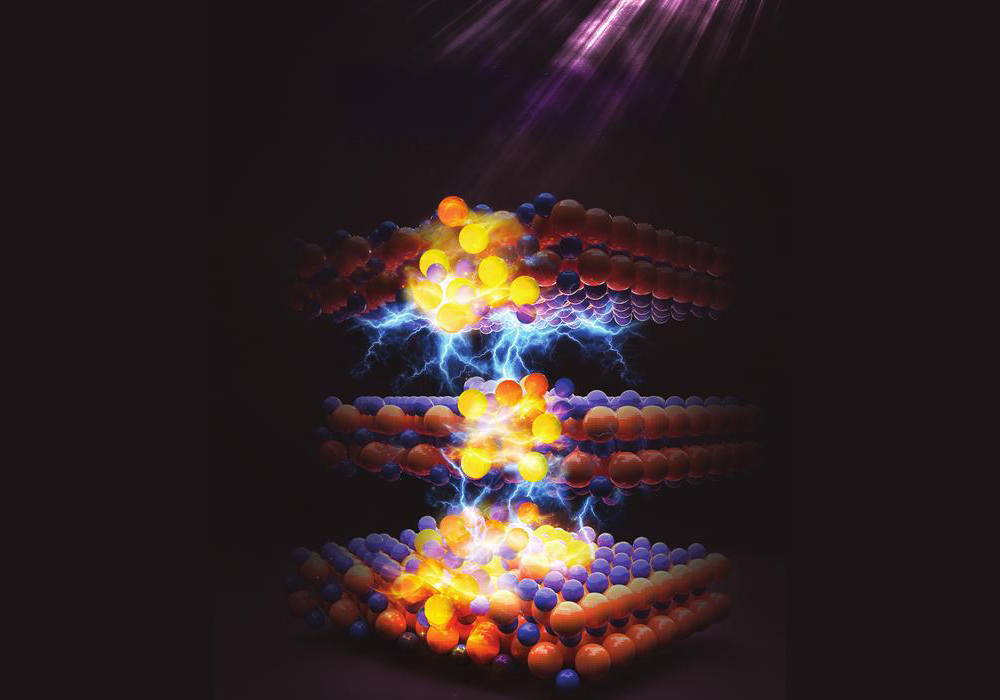Electrical conductivity is a pretty simple concept to understand: electrons move. Like water that flows downhill, they flow down a voltage gradient.
Not so simple is understanding why electrons are available to conduct. Where do they come from?
In most metals, electrons are everywhere—the “sea of electrons” we learn about in high school chemistry gives metals high electrical conductivity. In compounds, the electrons are not so available, but electrical conductivity still occurs. Even more interesting, electrical conductivity can occur by putting two complex materials together. What is it about their being together that creates conductivity?
For example, electrical conductivity arises at the interface of a polar metal oxide and a nonpolar metal oxide. A polar oxide’s structure alternates between positively and negatively charged atomic layers. An example interface which behaves this way is between LaAlO3 (a polar compound) and SrTiO3 (a nonpolar compound). It’s a phenomenon which could be used to control the flow of electricity in electronic devices like smart phones, or perhaps be the basis for entirely new kinds of devices.
The mechanism by which electrical conductivity is generated has been described by the theory of “electronic reconstruction,” which proposes that voltage increases with each atomic layer in the polar material. Eventually, the polar oxide becomes electrically unstable, and electrons flow from the polar side to the nonpolar side to stabilize the system, which sets up a conducting layer at the interface. The theory assumes that the interface is precise and that the oxides do not mix.
However, not all polar–nonpolar interfaces are conductive. Researchers at the Pacific Northwest National Laboratory and the University College London (UK) noticed that the interface between polar LaCrO3 and nonpolar SrTiO3 is insulating. Having previously observed conductivity at the LaAlO3-SrTiO3 interface, they wondered why one change in the lanthanate chemistry would make such a difference and what that was telling them about the conduction mechanism.
The research is published in a new paper in Physcial Review Letters. Lead author and PNNL Fellow Scott Chambers says in a press release, “These results suggest that the popular electronic reconstruction model is too simplistic to be as universal as it is clamed to be. Interfaces of polar and nonplar oxides are extraordinarily complex and the defy simplistic explanations.”
The team suggests that it is possible for there to be diffusion at the interface, which with the right combination of materials, leads to an insulating interface instead of a conducting one.
In their LaAlO3-SrTiO3 study, they determined experimentally that lanthanum and aluminum ions replace strontium and titanium ions in unequal proportions. Lanthanum has one electron more than strontium does, and it is freed when lanthanum crosses the interface. However, aluminum has one less electron than titanium does, so it grabs an electron when it crosses the interface. As long as more lanthanum ions than aluminum ions substitute into the strontium titanate, there will be excess electrons and conductivity will occur at the interface.
But, the LaCrO3-SrTiO3 interface is insulating. The team concluded that lanthanum and chromium diffused to the nonpolar side in equal amounts, so no excess of electrons was generated. Also, the electronic structure of chromium ions accommodates charge rearrangement in LaCrO3 in a way that the electronic structure of aluminum ions does not allow in LaAlO3. Thus, chromium provides a stabilizing influence, even when titanium moves into the LaCrO3, making electronic reconstruction unnecessary.
The next step will be to confirm the mechanism, which will require some advanced materials characterization techniques in order to know where the atoms are at the interface. “With sufficiently detailed understanding of their properties, this phenomenon can be understood, and may be useful for some novel electronic applications that cannot be done with conventional semiconductors such as silicon,” Chambers says.
The paper is titled, “Band Alignment, Built-In Potential, and the Absence of Conductivity at the LarO3/SrTiO3 (001) Heterjunction,” SA Chambers, L Qiao, TC Droubay, TC Kaspar, BW Arey, PV Sushko. (doi: 10.1103/PhysRevLett.107.206802)
Author
Eileen De Guire
CTT Categories
- Electronics

